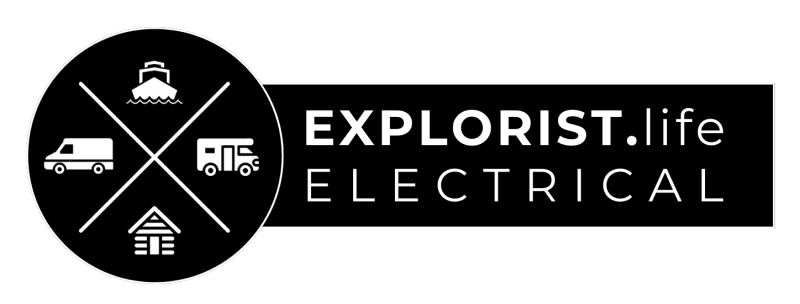
Back in lesson 3.1 of this academy, we covered why some 6 gauge wire can handle only 75 amps while other 6 gauge wire can handle 120 amps; but did you know that wire rated for 120 amps may be able to only handle 40 amps depending on where and how it’s installed? (Table 4E)
Clearing up the confusion on the max amps a wire can carry is exactly what I’m going to teach you here in lesson #4 of this Wire Basics chapter

Max Amps a Wire Can Handle – VIDEO

How many amps can a wire handle?
Back in lesson 3.1 of this academy, I taught you that the amps a wire can handle is greatly affected by its insulation temperature rating and Table 4A of the American Boat and Yacht Council Standard E-11 summarizes the various allowable ampacities of wire based on:
- Wire size
- Temperature of the insulation
- Whether the wire is installed in a hot engine compartment or not.

And on this chart we can see that 6 gauge wire with 105 degree insulation is rated for 120 amps when installed outside of an engine space, but only 102 amps when installed inside of an engine space.

This is because the heat created by pushing a wire to its max has to go somewhere in order for the insulation to not melt; and if the wire is installed in a hot location; that heat doesn’t really have anywhere to go.
If we go to Table 4B, the ampacities change.

This table shows the max ampacity when the wires are bundled together, in a sheath, or in conduit.
So, for more than one 6 gauge wire with 105-degree insulation; our allowable ampacity drops fairly dramatically down to 84 and 71 amps depending on if the wire is installed in an engine space or not.

This is the lowest that a DC wire gets derated.
Tables 4C through 4E shows the allowable ampacities of wires in AC circuits when:
- 4-6 wires are in a bundle
- 7-24 wires are in a bundle
- 25+ wires are in a bundle



Real World Advice
Based on designing ALL of the systems you can find in our store at shop.explorist.life 😉; I’ve noticed that in most applications, we hit voltage drop problems long before we hit ampacity limits of the wire when in a bundle AND when using wire with 105 degree insulation.
For example: Using the EXPLORIST.life wire sizing calculator; we can see that 6 AWG flowing 120A at 12V with 3% allowable voltage drop is only good up to 7 feet; which is only 3.5ft of positive and 3.5ft of negative; that is pretty short; and a pretty specific use case, and would realistically only be the length of wire from, say, a lynx distributor to a solar charge controller which are mounted right next to each other.

So in my experience, there is only a small use case where the derating factors of DC wires ACTUALLY matter, but since you’ve been educated on what to check for; now you can move forward and make your own decisions here.
Wire Ampacities of AC circuits
For AC wiring, there is actually a rule of thumb; which is:
- For 15A Circuits like lighting circuits, use 14 AWG Wire
- For 20A Circuits like standard outlet circuits, use 12 AWG Wire
- For 30A Circuits like higher powered appliances like welders, dryers, or RV hookups, use 10 AWG Wire
- For 50A Circuits like stoves, hot tubs, or 50A RV hookups, use 6 AWG Wire

BUT… Those ratings MUST be checked against the derating tables as well if the wires are zip tied into a bundle; but these rules of thumb hold true according to Tables 4C through 4E referenced earlier all the way up through table 4d which accommodates up to 24 current carrying conductors which allows for 14, 12, and 10 gauge wire to allow for 17.5, 22.5, and 30A; respectively, given you are using wire with 105 degree insulation.
If more than 24 current carrying conductors are used; the wires must be upsized because the derating factors have lowered the ampacity of the wire to below the rule of thumb.
How many amps can romex handle?
The same concepts apply here, but with solid core wire; we’d more appropriately be looking at the National Electrical Code instead of ABYC. The NEC has it’s own derating tables; which table 310.16 has a base ampacity for 90 degree wire, like romex, of 30 and 40 amps for 12 and 10 gauge, respectively.

Table 310.15 C (1) shows the bundle derating factors based on the numbers of current-carrying conductors in the bundle. So, if we are trying to use that ‘rule of thumb’ from earlier; as long as we stay below 6 current carrying conductors in our bundle, we are good to go.

Three things to note here:
- “Bundled” wires refers to “Cables or conductors that are tied, wrapped, taped, or otherwise periodically bound together. (520) (CMP-15)” per the NEC
- “Bundled” wires also only refers to wires that are “tied together or in contact with one another in a closely packed configuration for at least 1.0 m (40 in.)” (CMP-3) per the NEC
- The ABYC defines ‘Bundled’ wires as “Where single conductors or multiconductor cables are bundled for a distance greater than 24 in
Lastly… Regarding derating factors of the NEC vs ABYC; we’ve already talked about the ABYC having their ‘temperature’ derating factors based on if the wire is to be installed inside of, or outside of an engine space.
The NEC also has temperature derating factors; but they are much more complicated and specific than ABYC and you can see those derating factors in NEC Table 310.15 (B)(1)(1) where they give a 10 degree range with an associated derating factor for each range.
These ranges are there because unlike in boats, yachts, and RV’s, stationary installation temperatures stay pretty consistent; but only in the area of which the building is built in. For example: The attic of my house here in the mountains of northwestern Colorado will NEVER see the attic temperatures of an attic in Phoenix Arizona; and an arizona installation MAY have to use a little bigger wire because of that.
Conclusion
I hope this helps clear up why wire rated for 120 amps may be able to only handle 40 amps depending on where and how it’s installed as well as give you some insight into why certain applications may need larger or smaller wires.
Now; it IS worth mentioning that the system kits and diagrams we sell in our store over at shop.explorist.life have all of the proper wire sizes included or figured out for you.
We are going to be referring to max wire ampacities throughout the rest of this academy, so be sure to bookmark this article for future reference and come back to it if you need a refresher.
In the next lesson, I’m going to share some real-life wire choice mistakes I’ve seen so that you don’t make the same mistakes.
